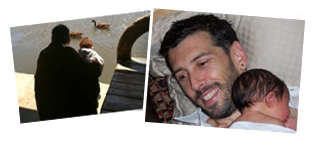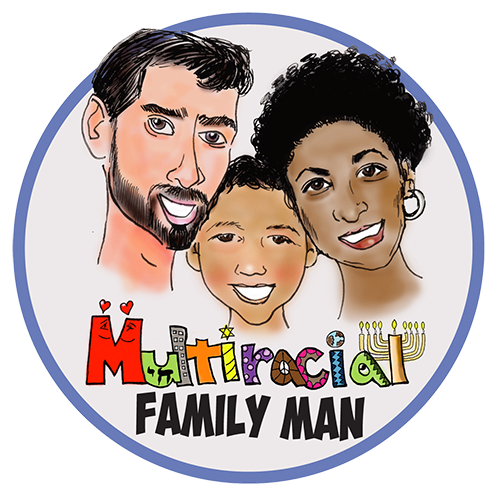My wife and I are an interracial couple (she’s Black, and I’m White), and we have a 3 year old Biracial son. Just as is the case with other toddler parents, we worry constantly about our own son’s education. Toward that end, we make it a point to read him bedtime stories, as it’s been proven that reading to kids helps them learn and read (plus, it’s a great way to get them to finally turn off the tv).
Because our son is Biracial, we try hard to get him books that reflect his own life experience. It’s not always easy, so we asked him to come up with some ideas, that we said we’d write if he provided the titles. Here are some of his suggestions:
1. Tan Is Exciting . . . . It’s the Color of Pancakes and Cookies!
2. My Mommy Is Black. My Daddy Is White . . . And, They Talk Too Loud During My Movies.
3. Barack Obama Is Cool. Lenny Kravitz Is Cooler. . . . No Daddy!! Stop Saying Fonzie Is Cool!
4. Our Family Is Many Colors Like M&Ms . . . Or My Boogers.
5. People Look Different But They’re the Same . . . . Except For the People Who Suck.
6. Everyone Should Get Along Together . . . . Or We Can Give Them a Timeout.
7. People Are Like Crayons. They’re So Many Colors . . . . And Kind of Stiff and Waxy and Non-Communicative.
8. Being Both But Not Taking a Bath.
9. Mixing It Up and Then Dropping It On The Floor.
10. Encyclopedia Brown And the Case of the Biracial Characters Missing From Disney Films
If you have interracial/biracial/multiracial children’s books, you want to share, please send along recommendations!!




10 Comments on “Books for the Biracial Toddler”
“Mixed like me” looks promising.
Thanks for writing.
Comment Wonderful have been doing pretty much the same as a Psychologist in training I find this to be the cutting edge of teaching with the (xy) generation wishing you guys much blessings….
Thanks so much for the kind words!
I am currently a librarian at the Brooklyn Public Library System- Carroll Gardens Branch. Here is an annotated bibliograpy that my classmate and I did for our graduate project on depiction of self-esteem of biracial children in children literature. I hope the following will come in handy
Picture Books
Alko, S. (2009). I’m your peanut butter big brother. New York: Alfred A. Knopf.
A young boy speculates on what his sister will look like when she is born.
Ada, A. F., & Savadier, E. (2002). I love saturdays y domingos. New York: Aladdin Paperback.
A young girl explains why she loves Saturdays y domingos because on those two different days she spends it with two different sets of grandparents from two different backgrounds who share their heritage and customs with her.
Adoff, A., & McCully, E. A. (1992). Black is brown is tan. New York: HarperCollins.
The book presents beautiful prose demonstrating the wonders of an interracial family.
Cheng, A., & Zhang, A. (2000). Grandfather counts. New York: Lee & Low Books.
A young girl thought that her Chinese grandfather did not accept her, but later realized it was because there was a language barrier; they are then able to bond through teaching each other how to count in Chinese and English.
Coy, J., & Fisher, C. (2003). Two old potatoes and me. New York: Alfred A. Knopf.
A father shows his daughter about how to grow potatoes.
Davol, M. W., & Trivas, I. (1993). Black, white, just right! Morton Grove, Ill.: A. Whitman.
A young girl is shown to be the “just right” mix of her white father and Black mother in personality and appearance.
Friedman, I. R., & Say, A. (1984). How my parents learned to eat. Boston: Houghton Mifflin.
This book tells the story of how a biracial girl’s parents met in Japan.
Graham, B. (2005). Oscar’s half birthday. Cambridge, MA.: Candlewick Press.
A family celebrates a baby’s birthday.
Igus, T., & Wells, D. (1996). Two Mrs. Gibsons. San Francisco, CA: Children’s Book Press.
A young girl shares how she is blessed with two different Mrs. Gibson’s in her life while learning each of their customs.
Johnson, A., & Soman, D. (1996). The aunt in our house. New York: Orchard Books.
A woman moves into her brother’s house after her house was destroyed and integrates into the family unit.
Monk, I., & Porter, J. L. (1999). Hope. Minneapolis.: Carolrhoda Books.
Hope, a biracial child faced with discrimination, learns from her Aunt Prudence how to overcome discrimination by explaining the significance of Hope’s name.
Monk, I., & Porter, J. L. (2001). Family. Minneapolis: Carolrhoda Books.
Hope learns more about the Black side of her family while vising her Aunt in this sequel to Hope.
Shin, S. Y., & Cogan, K. (2004). Cooper’s lesson. San Francisco, CA: Children’s Book Press
A young boy is caught stealing by a Korean shop owner and is then helped by the shop owner towards accepting his biracial status.
Wing, N. (1996). Jalapeño bagels. (1996). New York: Atheneum Books For Young Readers.
Pablo is initially confused on which food of his parents’ cultures he is going to bring for International Day at his school since he is part Jewish and Mexican; to resolve the conflict he brings a jalapeño bagel, a perfect fusion of both cultures.
Winstanley, N., & Nadeau, J. (2011). Cinnamon baby. Toronto: Kids Can Press.
An interracial couple does everything they can to help their colicky baby; the only thing that is able to calm the baby is the scent from the loaf of cinnamon bread from the mother’s bakery.
Children’s Chapter Books
Chang, M. S. (2009). Celia’s robot. New York: Holiday House.
Celia’s father has made a prototype of a robot as a companion for her when both parents are tied in their careers, but finally they realize that their daughter is worth a lot more than their careers when Celia is almost killed trying to recover the stolen robot.
Chocolate, D. (1994). Elizabeth’s wish. Orange, N.J.: Just Us Books.
A biracial girl who is being bullied learns to accept herself as Black through the help of her African-American friends.
Curry, J. L. (2005). The black canary. New York: Margaret K. McElderry Books.
A boy is transported back in time to England in 1600 where he is largely accepted, but is treated as a bit of a curiosity due to his biracial heritage.
Frazier, S. T. (2007). Brendan Buckley’s universe and everything in it. New York: Delacorte Press.
Through his love of discovery and studying minerals, Brendan Buckley discovers his identity and in the process helps his grandfather come to terms in accepting a biracial grandson and his daughter in an interracial marriage.
Frazier, S. T. (2010). The other half of my heart. New York: Delacorte Press.
Two twin sisters with different skin complexions and personalities discover who they are as biracial teenagers while participating in the Ms. Black Pearl Program.
Grimes, N. (2006). The road to Paris. New York: G.P. Putnam.
Paris, feeling abandoned in foster care, finally feels a sense of belonging when she sees people who appreciate her for who she is.
Magoon, K. (2011). Camo girl. New York: Aladdin.
A girl who is an outcast at her school has to decide whether popularity or loyalty to her friend is more important to her after a popular new boy takes an interest in her.
Marsden, C. (2010). Take me with you. Somerville, Mass.: Candlewick Press.
Susanna, an orphan in an Italian convent, discovers her biracial identity.
Namioka, L. (2003). Half and half. New York: Delacorte Press.
Fiona, unsure of what racial identity she should declare herself after the question is posed on a school form, becomes further torn when trying to placate her Scottish grandparents and Chinese grandmother at a folk festival.
Partridge, E. (2011). Dogtag summer. New York: Bloomsbury Books for Young Readers.
A biracial girl born in Vietnam to a GI father and a Vietnamese mother reflects on how the past influences her present status as an adopted child in California.
Riordan, R. (2010). The red pyramid. New York: Disney/Hyperion.
A fantastical tale of an orphan brother and sister who have to save the world from the Egyptian god Set’s plans for doomsday.
Schwartz, V. F. (2000). Send one angel down. New York: Holiday House.
Being born into slavery, Eliza faces more hardship when the slave owner and others become aware that she is a byproduct of the owner having relationships with slaves.
Stauffacher, S. (2010). Animal rescue team: Special delivery! New York: Alfred A. Knopf.
The Carter family, an interracial family, comes to the aid of a distressed deer.
Stauffacher, S. (2010). Animal rescue team: Hide and seek. New York: Alfred A. Knopf.
The Carter family, an interracial family, devotes their life to rescuing distressed animals.
Woodson, J. (2000). Miracle’s boys. New York: G.P. Putnam’s Sons.
Three inner-city brothers go through the trials and tribulations of trying to cope with the loss of their mother and their inner issues.
Young Adult Books
Anderson, J. L. (2009). Border crossing. Minneapolis, Minn.: Milkweed Editions.
Manz, a byproduct of a Mexican father and a white mother, becomes obsessed about “the man” who is coming after him due to his being part Mexican.
Bruchac, J., & Comport, S. W. (2005). Whisper in the dark. New York: HarperCollins.
Maddy, who is part Native American, begins to notice that the legend of whispering in the dark is coming to haunt her because of her family’s lineage.
Crutcher, C. (2001). Whale talk. New York: Greenwillow Books.
A well-adjusted teenage boy seeks to help the school’s outcasts gain self-esteem through the formation of a swim team.
De La Peña, M.. (2008). Mexican whiteboy. New York: Delacorte Press.
A summer in a Mexican neighborhood in San Diego with his father’s side of the family spurs feelings of self-hatred and cultural inauthenticity for a half-white, half-Mexican teenage boy.
Easton, K. (2007). Hiroshima dreams. New York: Dutton Juvenile.
Lin is conscious that she does not look like the other popular girls but learns to finally accept who she is through the Koan (riddles) that her Japanese grandmother taught her.
Hamilton, V. (1993). Plain City. New York: Blue Sky Press.
Buhlaire feels incomplete over not having a father, until the principal reveals that her father is still alive and well; once she meets him she began to feel whole again.
McDonald, J. (2007). Off-color. New York: Farrar, Straus and Giroux.
Cameron, a teenage girl who believes herself to be white and who mocked Black people sees her pristine world collapse when she discovers that she is part Black.
Meyer, C. (1997). Jubilee journey. San Diego: Harcourt Brace.
Living in a diverse community with acceptance for biracial individuals, Emily Rose Cartier and her brothers learn what it mean to be Black when they get invited by their great grandmother to attend Juneteenth Jubilee in Texas.
Ostow, M. (2006). Emily Goldberg learns to salsa. New York: Razorbill.
Growing up Jewish, Emily was not aware of her Puerto Rican heritage until after her grandmother’s death , where in Puerto Rico she learns not only her roots but how to dance salsa.
Reynolds, M. (1999). If you loved me. Buena Park, Calif.: Morning Glory Press.
A hot-headed teenage girl has to make decisions about whether to forgive her cheating boyfriend and her formerly drug-addicted father.
Sanders, S. L. (2009). Gray baby: a novel. Boston: Houghton Mifflin.
A snapshot of a teenage boy going through a complicated period in his life; he meets his estranged grandfather, he confronts past demons about the racist police officers who killed his father, and he helps pursue a kidnapper of the sister of a girl he likes.
Smith, S. L. (2008). Hot, sour, salty, sweet. New York: Delacorte Press.
A high-achieving biracial girl worries over inviting her crush to a middle school graduation party, believing he would prefer to date a white girl over her.
Wenberg, M. (2010). Stringz. Lodi, N.J.: WestSide Books.
Jace Adams, feeling abandoned by his parents and living in a new city, always finds solace in his cello.
Woodson, J. (1997). The house you pass on the way. New York: Delacorte Press
Straggerlee is constantly being stung with the whispers that the town people have about her interracial family, but the sting that hurts the worst is the whisper she has within herself.
Young, K. R. (2004). Cobwebs. New York: Greenwillow Books.
A teenage girl worries that her spider powers will not develop to the extent that her
parents’ powers did.
Good Luck. I can be reach at jflores@bklynlibrary.org.
This is awesome!!
Wow – yay for librarians!
You said it!
Very nice article as well as book list. Thanks to all for Sharing. Best wishes for you and your family Alex.
Thanks so much!
Leave a Comment